Epic 2021 day 1 conference notes
I’m back (virtually) at EPIC again this year! I’m going to try to reprise my live note taking from EPIC 2018 though I probably won’t be able to be as comprehensive as before.
Direct quotes are in quotation marks. Everything else is my notes/paraphrased.
Keynote: The Future of Audiences and Mixed Reality Performances
Sarah Ellis, Director of Digital Development for the Royal Shakespeare Company

Going to talk about a project called Dream, which is part of the Audience of the Future programme.
Audience of the Future was all about investment in research and development, and collaboration.
Q was: How to have a relationship between practictioner and research to look at future tools
Dream was a live, online perfomance set in a virtual forest. Uses real-time mocap, VR, Gesturement (interactive music), Unreal Engine, to combine live and online.
Dream was never supposed to happen. came through the pandemic and a pivot that we had to do during the pandemic.
Project started when they were broadening perspective from a previous project with Intel in 2016. Had lots of different partners including Marshmallow Laser Feast (MLF) and Philharmonia Orchestra. Partly research project but the main deliverable was a performance.
But when Pandemic hit, all they had was this music that was recorded the week before the pandemic hit.
How we anticipate the future and think about the future
This wasn’t a Shakespeare play in the way that you ahd expected it or anticipated it, and that’s why we all came together to explore (tools and audiences of the future)
Shakespeare plays “are great reference points for us to explore”
Every student in the UK learns Shakespeare and most of the world have some connection to it so we have a responsibliity to make Shakespeare relevant to people today.
7mx7m performance volume represents 7kmx7km space in VR. audience and actor saw same backdrop.
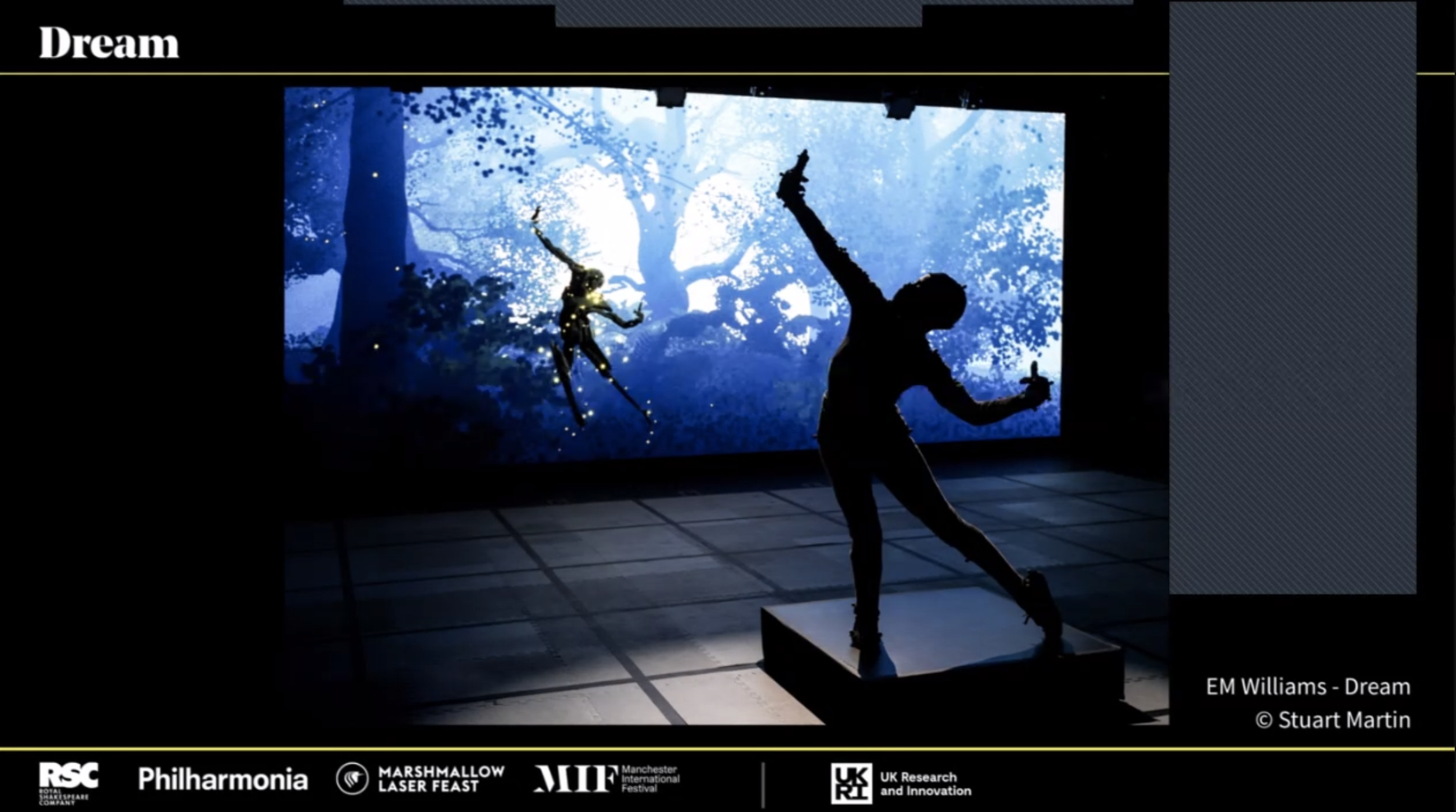
Was not a linear performance of midsommer night’s dream but that also reflects the fact that the world itself was in flux.
Puck was the character and you ahd to help them find their way through the forest - during the way you meet other characters from Midsummer night’s dream.
We needed to create a world that people believed in and emotionally engaged in.
How can we use these technology to see how to hold live performances and virtual spaces at the same time?
If you look at film, animation, etc, actors have adapted their craft for the performances required by those formats - same for gaming technology (i.e. mocap+VR) now.
We need to give actors (using the technology) the best chances and best ability to establish the emotional connection online. and ensure that the tech doesn’t fail.

lockdown - no live performances, no physical gatherings. So we needed a pathway to reach audiences, online.
Commissioned research (a survey) to ask audience where they were at. Came back with 3 compelling headlines for us:
- Craving togetherness
- Craving liveness
- Huge digital inequity in people’s homes.
We have abelist biases around what technology audiences have access to.
This performance was not just performed at 8pm every night. We changed the performance time to cater to audiences around the world.
We couldn’t justify making a performance for VR headsets in the home (there aren’t enough VR headsets). We couldn’t justify even mkaing a performance for the most up-to-date iPhones for example.
We built this experience for desktop, mobile, and tablet even if it was lower-spec
We shouldn’t assume everyone has access to really high-spec wifi
These are the challenges we have now in hybrid working
“We are in a world of creators so they know how to make work and they know what it takes to make work. But if we look at [the popularity of] minecraft, etc they also know what these works are about.”
When we’re looking at emergent technologies, what we don’t have is the rituals and culture that we have with physical performances. Anyone who has been to the theatre there are anticipations. You might not think about them up front or consciously but we do them together [to create the anticipation].
These rituals are starting to emerge (we wave goodbye on zoom meetings, etc)
We need to really, really re-address the issues of who’s making this content, who this content is for,
need to think from a non-abelist perspective. For example, BSL performer doesn’t need to be on a separate screen/box on the side, but can be inte
reached 65k audiences from 92 countries. Audience stats:
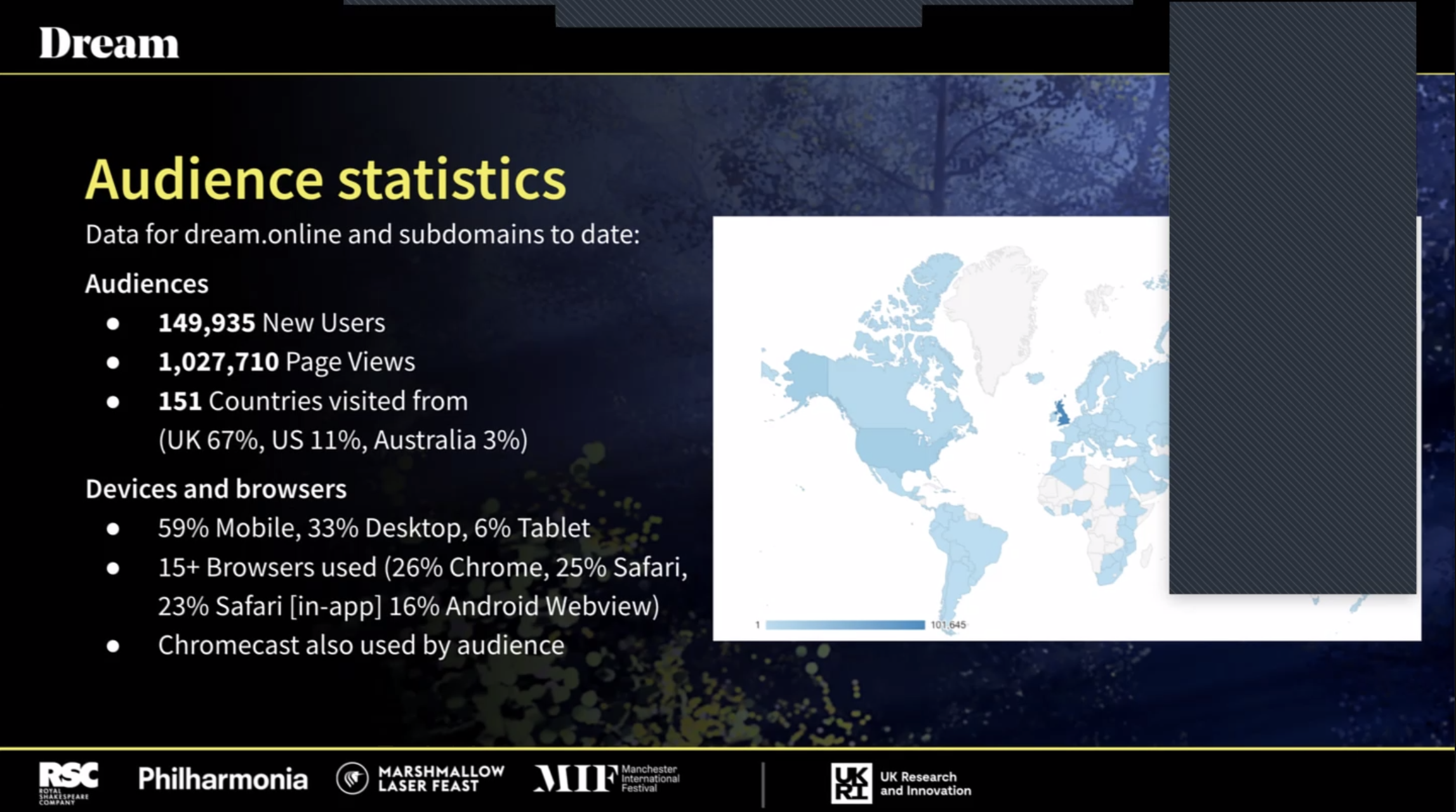
We keep coming back to how do we converge and bring together generations. This was able to do that.
Younger audiences absolutely claim interactivity unconditionally but for older audience, that needed care and invitation.
With our research partners, needed to think about: a) what the audience needs were, and b) What does meaningful togetherness entail
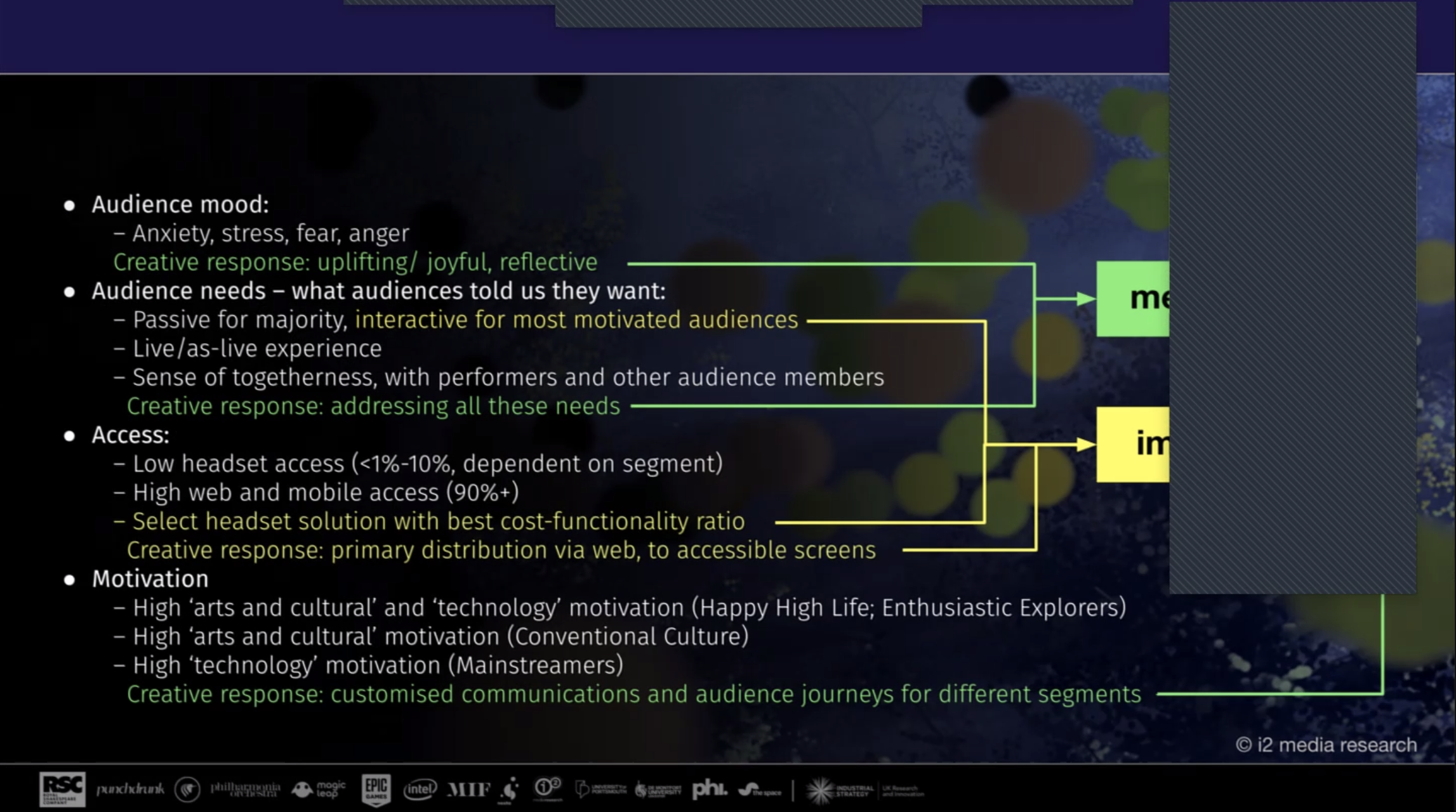
Rather than make creative assumptions about what would land with the audience, used research.
In cross-discipline collaboration, need to really think about and be aware of language and how it means different things to different people. ‘meaningful’ means differen things to a theatre-maker vs a technology partner, for example.
What ‘meaningful’ means
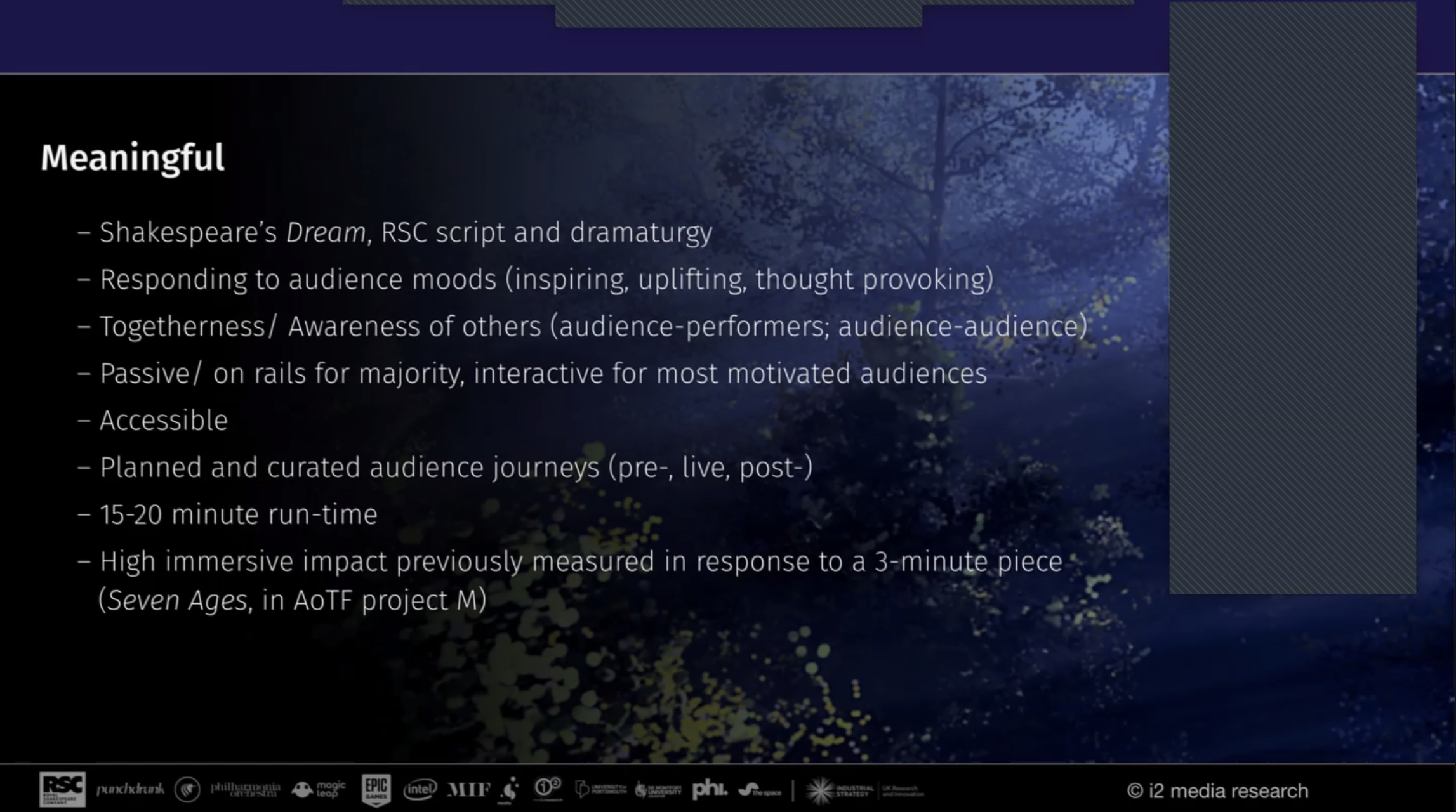
What ‘immersive’ means
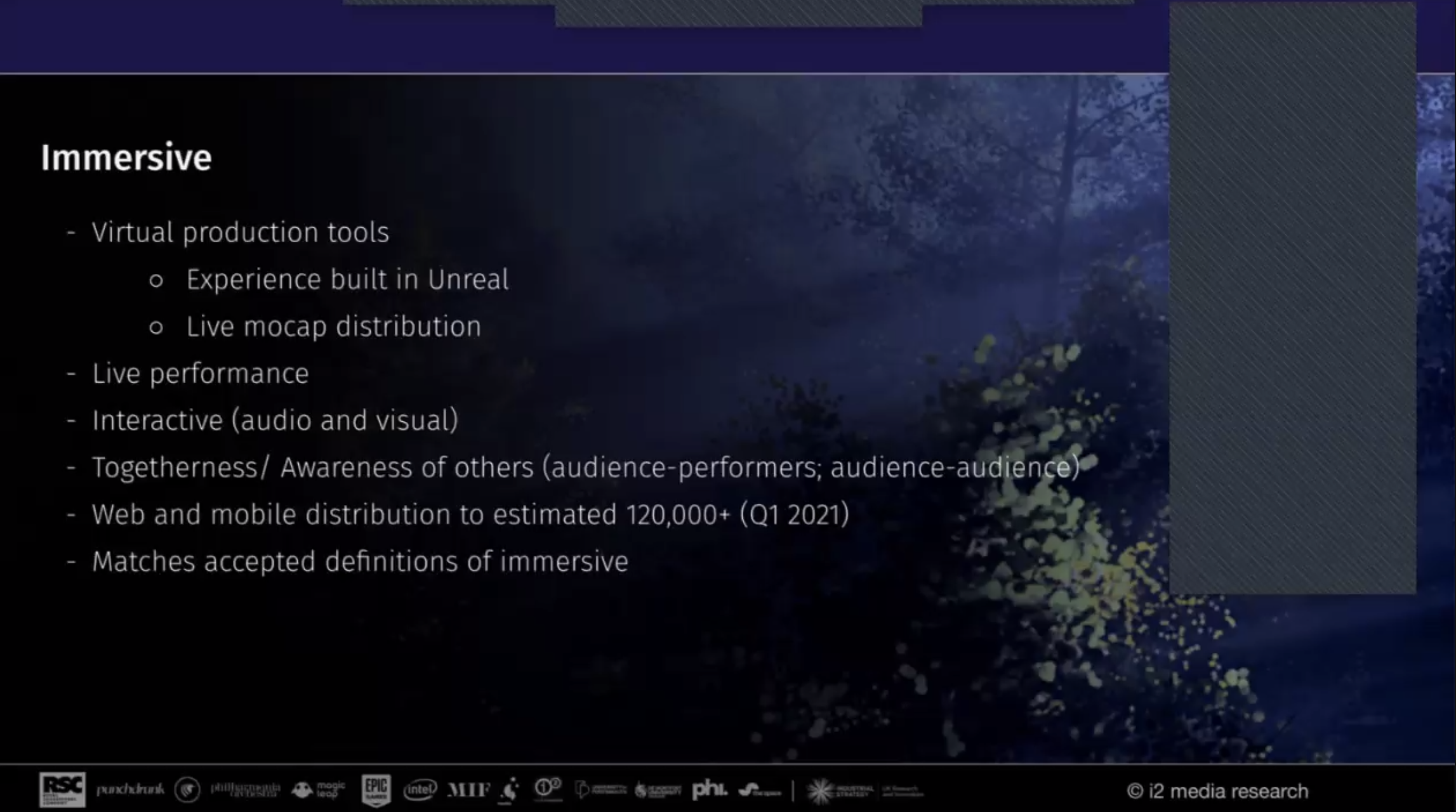
This time, needed to conside the entire audience experience.

We made a whole website for people to experience this in. Not just a youtube link that you were sent.
Also designed a customer care plan.
But in future “There’s going to be a point when some of this distribution and infrastructure we won’t need to make” all of that themselves.
[Accessibility] is something that is still isn’t right and still isn’t working enough in how we build digital works and performances. We’re still really led by the technology.

Some of the least technologically advanced work was the most exciting for audiences. There was a ticker that showed how long until the show began and people really took to that as it created a sense of anticipation for them.
“We are no longer the people that you come to, as cultural practictioners. We come to your home”
As important as the performance was, what we had to build was the ritual around it.
We’re still in broadcast mode. next step, is how we get audience to connect to each other.
Traditional forms have all these sets of assumptions and what’s exciting with these new digital forms is that when you break those assumptions, you let the audience back in.
Keynote - Exiting the Road to Hell: How We Reclaim Agency & Responsibility in Our Fights for Justice
Panthea Lee is a strategist, organizer, designer, and facilitator, and the Executive Director of Reboot
Her parents wanted her to be an architect, to be a business person and to be a lawyer but she was drawn to ethnography and journalism.
Used Ikea as an example
As an immmigrant kid always felt out of place and had a curiosity about humans: if i understand them better maybe i can better fit in Maybe I could change the world in ways to better serve people like me.
Spent time in China as ethnographer and journalist. Was animated by questions such as these (which are from a class she was teaching at the New School)
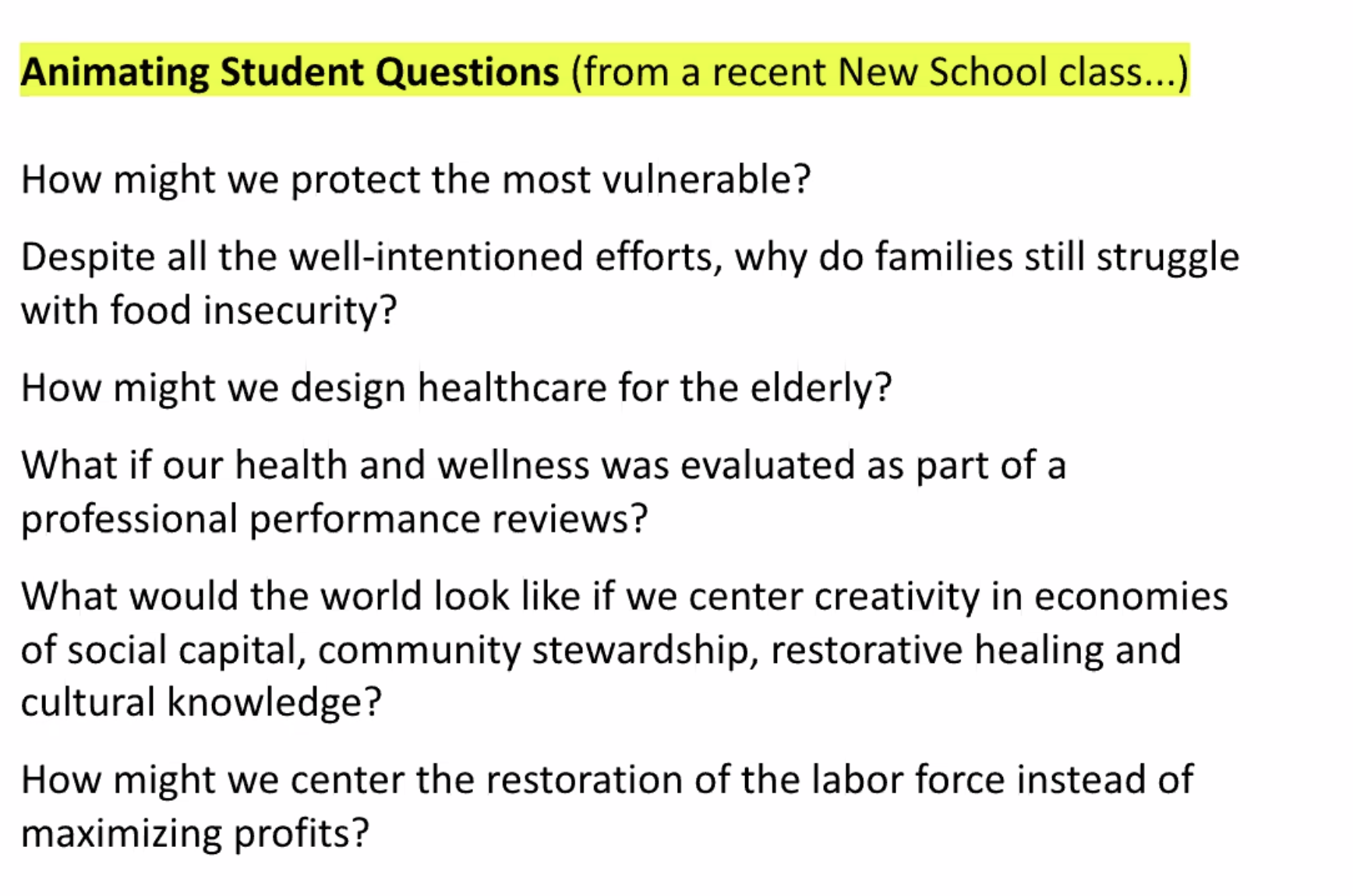
Every single one of them talked about empathy as their super power.
I’m largely brought on by instituions with money and power who want to do good, and have often benefitted from inequity and injustice in the world that have supported their endowments.
She was gathering stories from people like this (i.e. those without power) and bringing them to institutions and rooms like this (i.e. corridors of power)
But had a sense that something was wrong.
Then 2016-2020 happened. Empathy became a buzzword. Joe Biden was seen as the empathetic president.
This was supposed to be good, but something felt off.
lightning bolt struck when she heard Aruna D’Souza
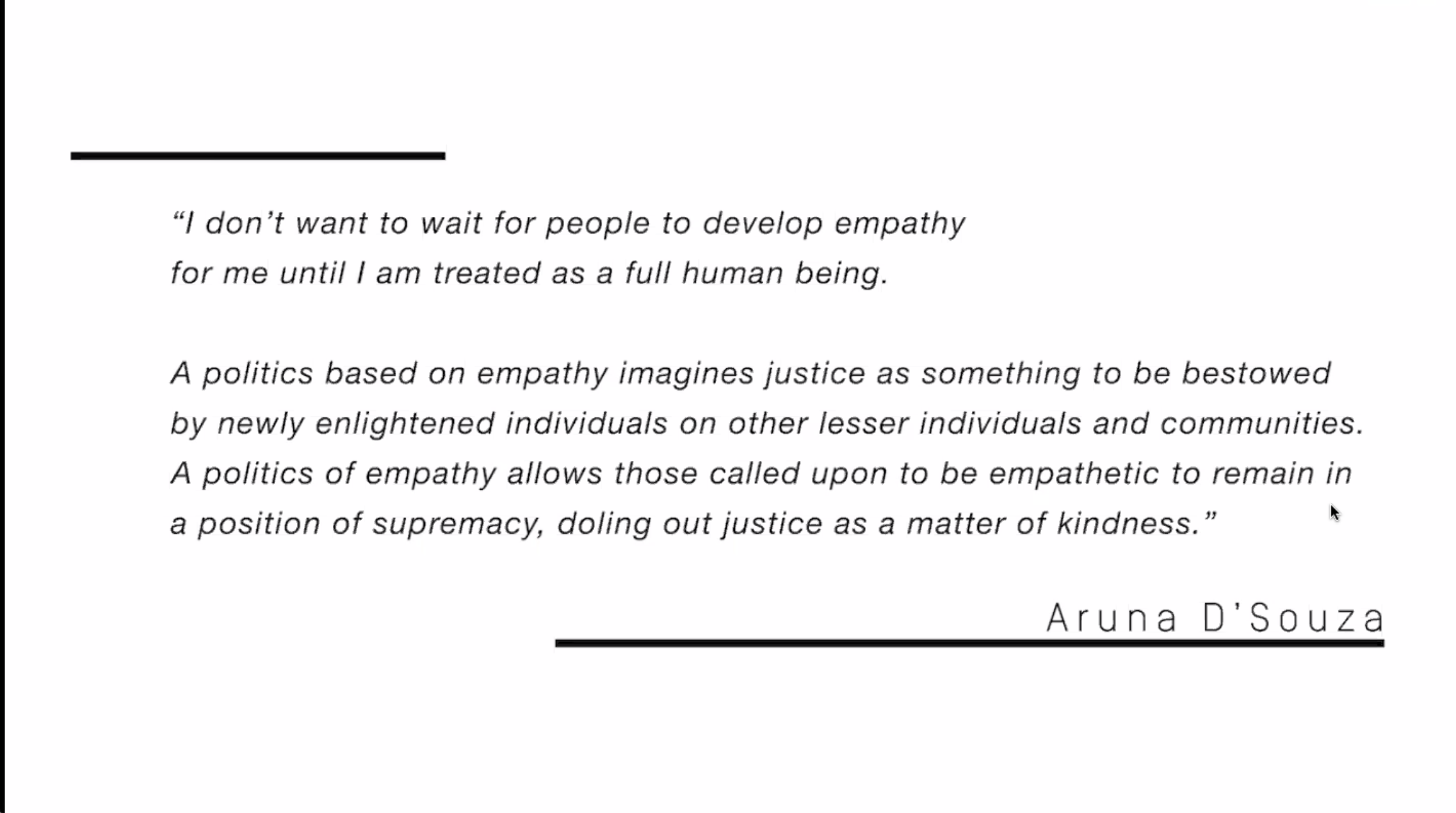
Realised that empathy as a tool of transformation has flaws:

and that she was complicit.
References a 2016 article from Tricia Wong questioning the ‘How might we’ framing - why it’s insidious and why we need to overcome this.
Recognized that much of her work has been in the majority world, while being part of a generation that is looking for meaning and looking to make a difference.
They have the privilege/luxury of being able ot drop in and out of the ‘field’.
This became clear with a project with a federal agency.
With the project, although the intention was to empower local actors (downstream) and facilitate their development, the reality was that the work was primarily used to report and justify (upstream) the return on investment of the engagement.
She reflected onthe setup and the logics and the mythologies embedded in our governing institutions.
Chiefly, Hobbes and his (flawed) understand of human nature

During pandemic, Rebecca Solnit’s book, A paradise in hell, was a bestseller. It showed that people came together (and were distinctly not Hobbesian) in times of crisis. But question is why this only happens during times of crisis. Solnit posits that it’s because in crisis, state doesn’t function as a safety net so people are forced to come together.
This has implications for our work [as researchers].
She is trained as a mediator, and in mediation, in 80% of mediation cases, the final statement is framed in the narrative terms of the first to speak.
This explains why reforms and working from the inside often doesn’t work.
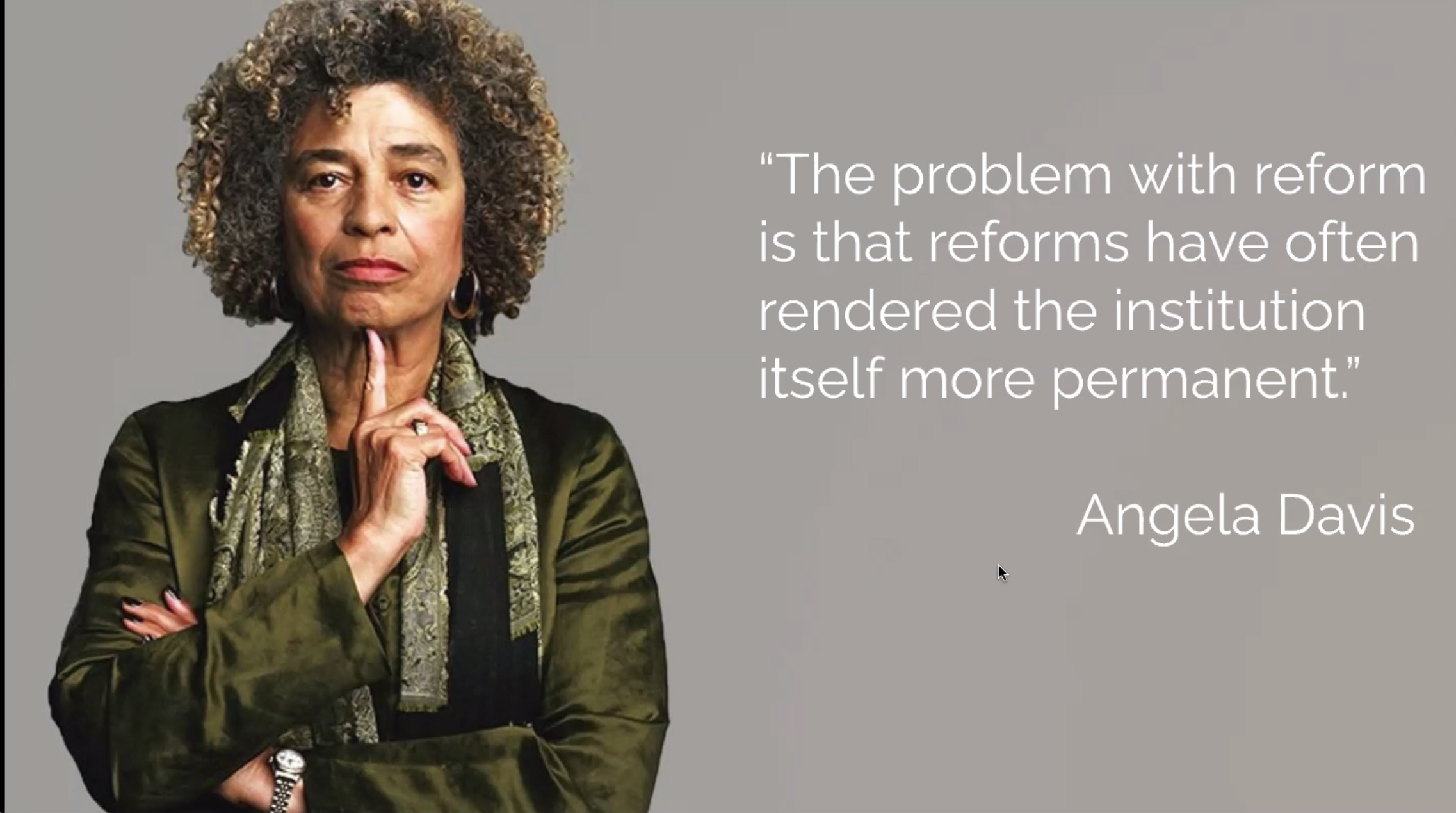
She had experience as someone coming in to organisations to reform and change from the inside. Did some good, but realised shge was ultimately wrong. At the end of the day, many detractors, activist and students who wanted to work on social justice and anthropology end up being used as a tool for Institutions to just do to make the minimum viable redress of grievances, and then keep on keeping on.
We need to rethink the role of empathy and how we can create more structural justice. We need to then grapple with history, power, context, ethics and equity.
A concrete example: a project in Nigeria that involved doing ‘fiscal ethnography’ around supposed corruption and waste.
Realised that the surface problems were symptoms of bigger structural issues. People did not feel accountable to these ‘modern’ forms of government because it had been imposed on them. They followed their way of doing things but had to ‘hide’ that from international actors, which showed up as ‘corruption’
Ended up negotiating policy agreements between the international financial institution and the Nigerian government, to be able to provide essentially development policy funding.
Thinks a lot about the institution she works for, and whether their work is essentially trying to export the IKEA model, except that instead of cost effective Swedish design, we’re exporting Neoliberal capitalism, that is enriching our countries and continuing to oppress and suppress.
Need to reckon with historical injustice. Design talks a lot about ‘beginner’s mindset’ but that’s BS - it places the burden of educating on those that have been historically marginalized.
Often we get hired in to study people and we think the problem is people, but we need to look inwards and upwards.
There’s a disconnect between what students think they want to do, and the jobs that are available.
Following Anand Pandian, we should reclaim what is magical about our work
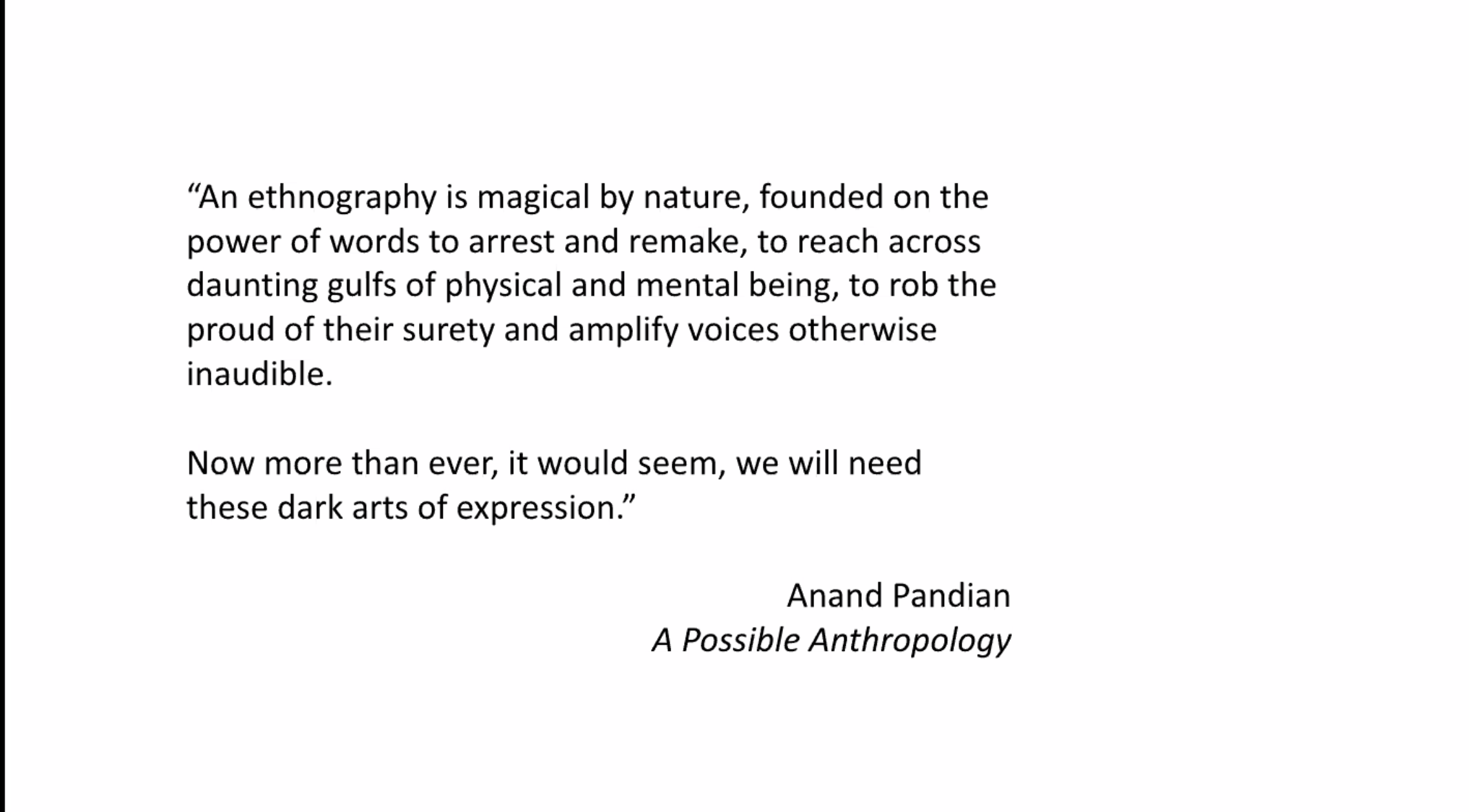
People do want to connect and understand each other and reach across the divide, but to do so, we need to work vertically:

Ethnography, at it best, help us understand where each of these different actors are coming from, and how to harness all our superpowers in the fight for justice in the fight for equity.
“I want to reverse who is getting to ask what questions in society and shape the world that we live in.”
“Most of us here work for companies and work for governments. When these folks are asking what the future should look like, we get the version of reality that we’re living in now.”

Right now we’re in a period where we don’t know how to have complex we don’t know how to argue with each other we don’t know how to mediate the deep tensions and divisions at our core
Seeking new futures
Leveraging Speculative Design to Re-imagine Product Roadmaps Sanya Attari, Facebook Charley Scull, Facebook Mahboobeh Harandi, Syracuse University
Product roadmaps tend to focus on immediate needs at the expense of more distant product horizon and a more holistic product vision.
also, features tend to get their own teams and their own roadmaps in big companies, so it’s easy to become siloed.
Speculative design less a specific method and more of an experimental mindset to expand the boundaries of the possible, by unshackle in the imagination from the constraints of the present.
Took two approaches to speculative design: ‘jump to the future’ and ‘gradual disclosure’.
Jump to the future more of a ‘one-off’, to capture participants reactions as they are dropped into a dramatically different future
Gradual disclosure is happens over more of a period of days: participants are presented with an increasingly nuanced and layered reality through cumulative artifacts and workflow experiences.
The approach beyond ended up helping the teams better anticipate the time horizons for impact.
Searching for the Next Billion Jennifer Zamora, Google
Global design for information seeking across cultures.
Many people are familiar with search engines but a lot of current tech hardware and software are designed from a Western perspective, even though majority of internet users are outside of the Western world.
But, as ‘next billion’ comes online, see new info-seeking behaviours. So, did research - with Q: What are the barriers to info-seeking in different cultures?
Found 5 barriers:
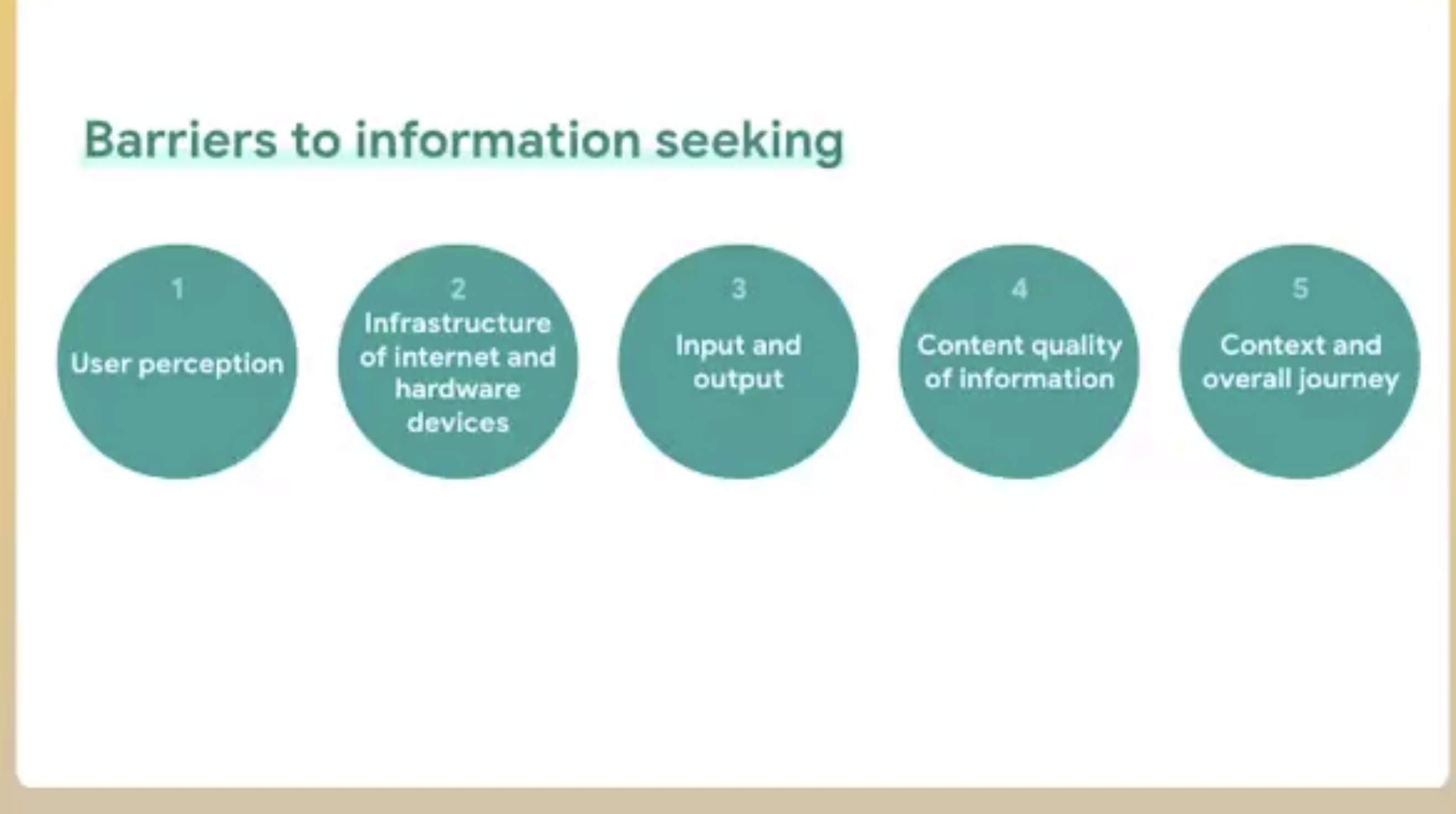
Anticipating Headwinds: Using Narrative to overcome entrenched resistance to change Kate Sieck
Ethnographers generally are catalysts who embrace change and uncertainty, but often work with people who do not share the same bias. They prefer the familiar, the comfortable, where they understand the rules where they understands what expected.
There are tactics to help people get over those initial moments of hesitation and resistance. But it’s really not very good at sustained change and it’s not very good at long term change, which ultimately leads to conflict.
Wanted to find a different way, so started looking at narrative, and at the metaphor of sailing where you have to tack against the wind instead of sailing direclty into headwind.
What would narrative ‘tacking’ look like?
Bruner:
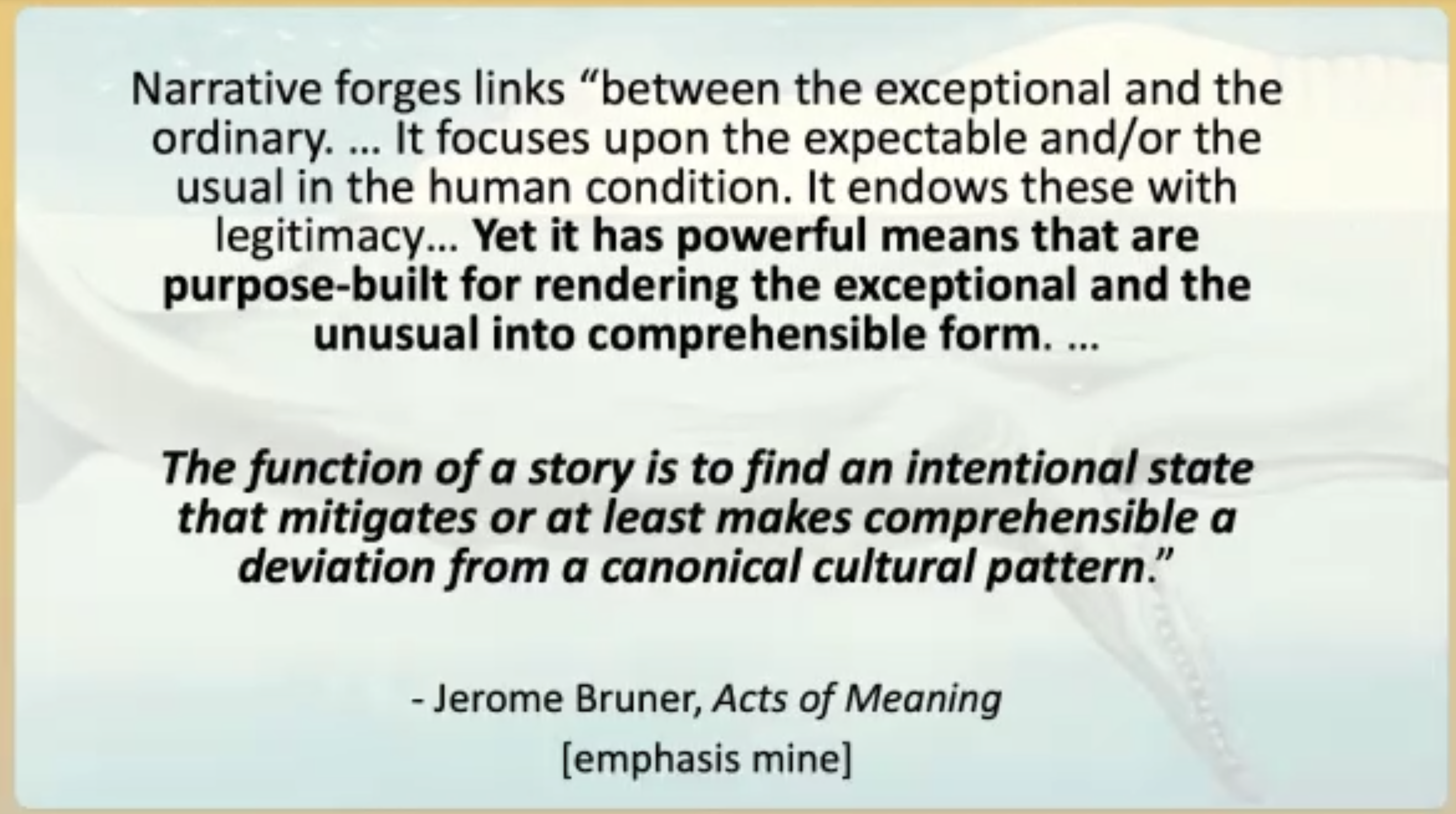
When you compare that to what’s being advocated in change literature, you see the mismatch. Change literature focuses too much on behaviour, and focuses too much on painting a picture of the future.
Instead, we should ask about intentionality: Who are you in this world. What matters to you why do you love this place. What would you lose.
Example of individual change - alcholism. This is the starting point; this is their story:
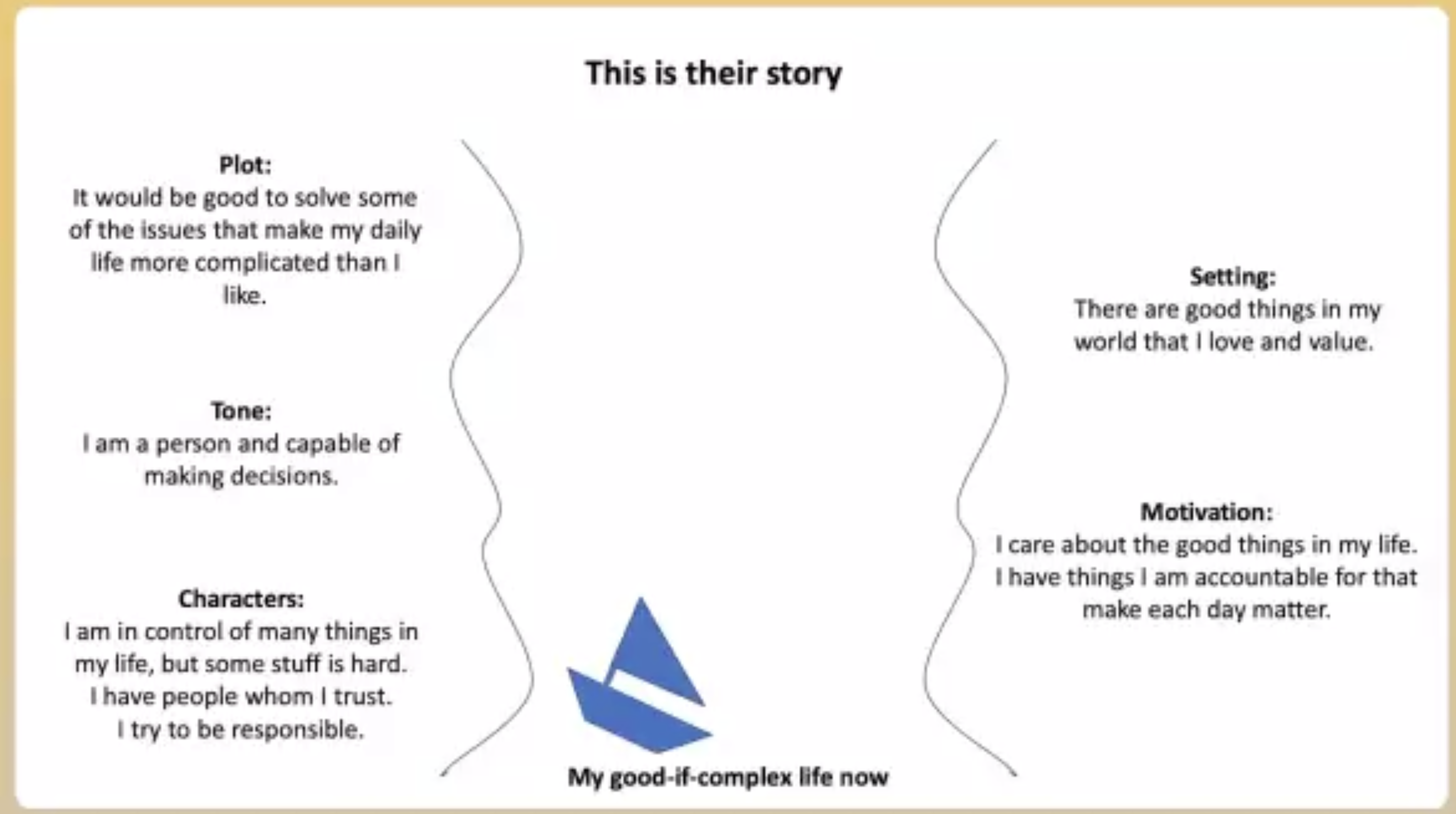
and this is the intervention:
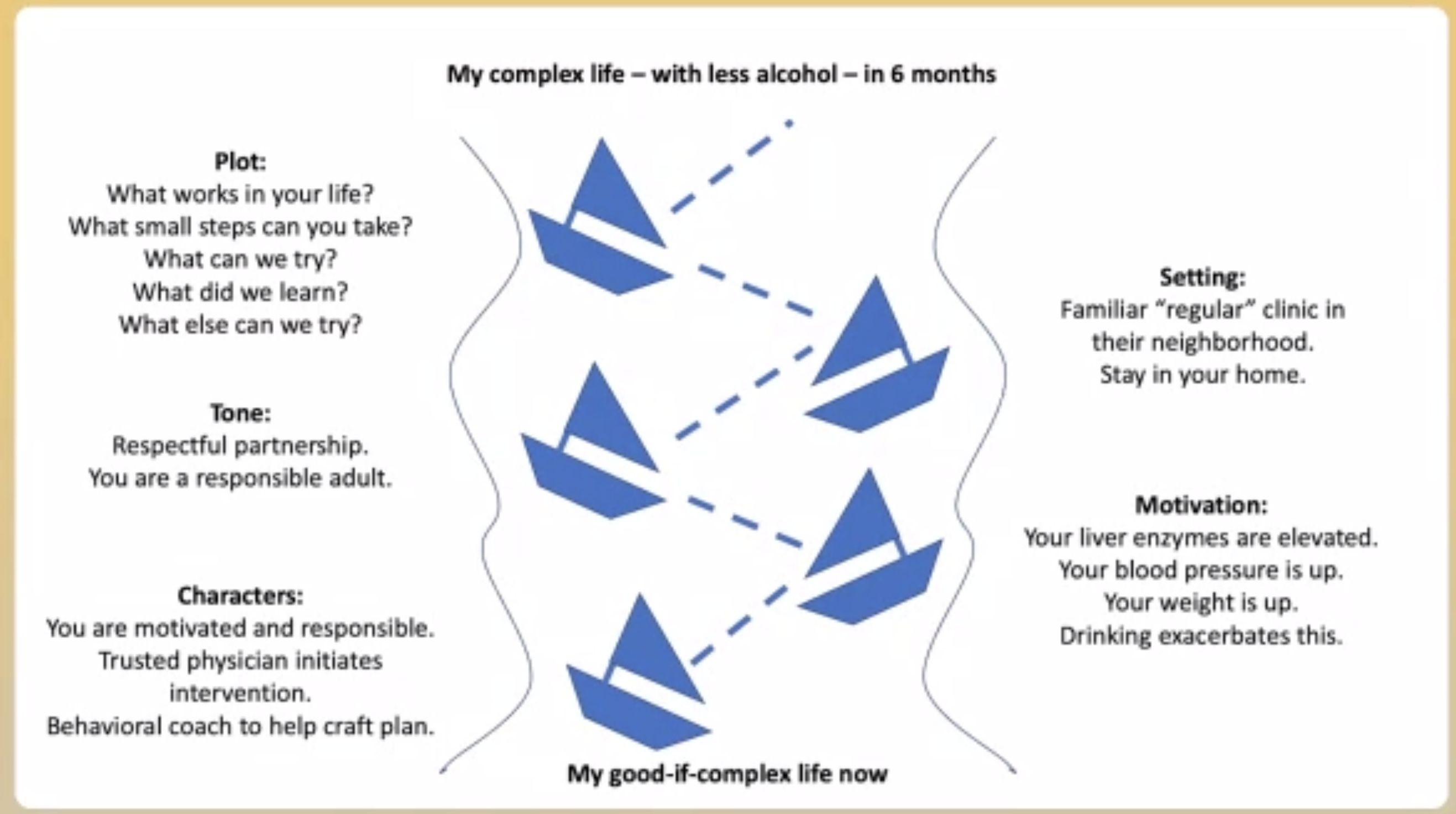
Result: got 60% of people into the programme and and 35% completed.
And the framework, generalised:
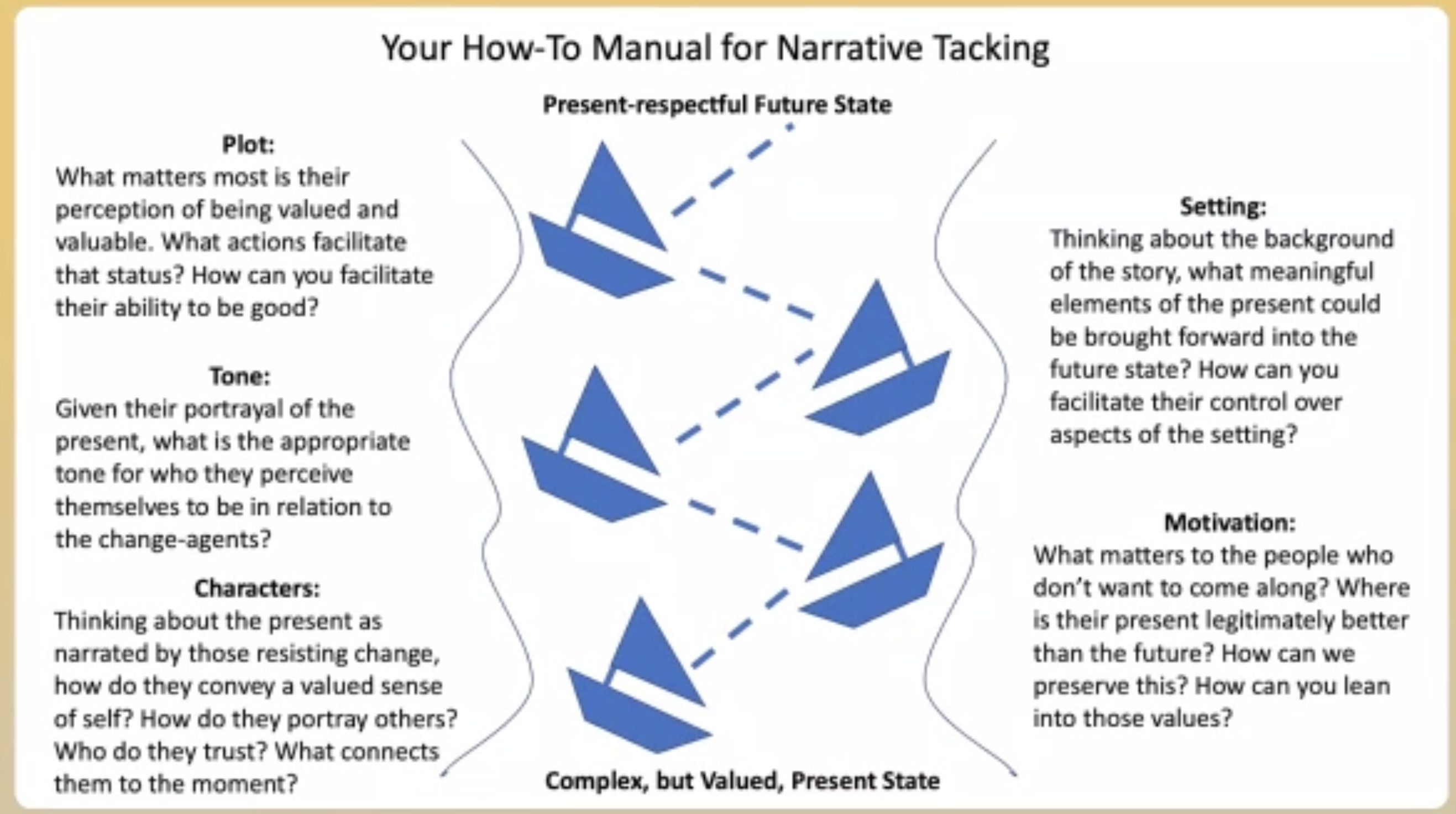
Alternative Methods - Pecha Kucha
Not many notes for these, sorry!
Our Advocacy Practice for Their Change Amanda Rosenberg, Workday
“Insight gatherers become insight socializers”
Thinking through loopholes Laura Reiss, Independent
“Contrary to what common sense thinks, intuition is not a natural gift. Intuition requires experience, exposure, effort, and a dive into a particular subject.”
“Recognizing patterns requires technique”
Reconfiguring Home: Seeing remote work and school through mothers and their children Chloe Chang & Vinay Kumar Mysore, Open Box Design
“We learned that some of the main triggers for the stress and pressure facing moms was based on their own assumptions about what they thought their kids thought of them as mothers”
“Designing for kids meant thinking like moms”